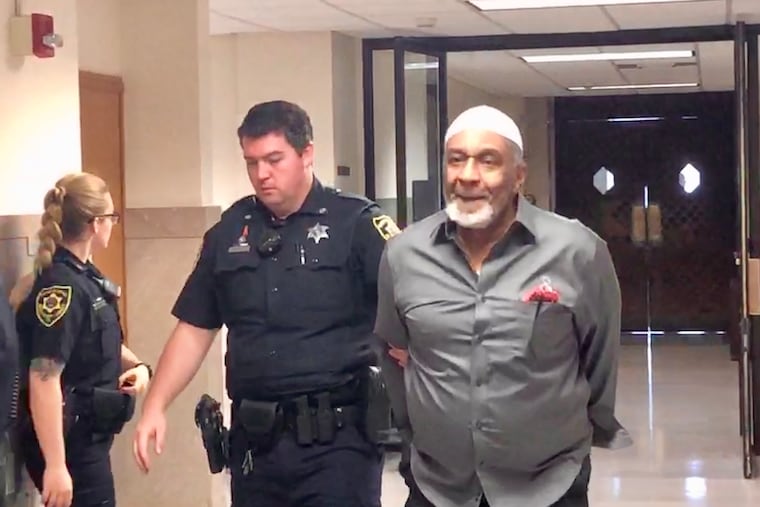After a mistrial last year, a Montgomery County man will again face a jury in his girlfriend’s 1980 murder
Robert Fisher, 76, is accused of killing Linda Rowden as she drove him around Norristown in 1980. After several successful appeals and one hung jury, Fisher is back in court again this week.

This week, for the fifth time in his life, Robert Fisher will go before a jury and attempt to convince it he did not kill his girlfriend.
Fisher, 76, is charged with first-degree murder in the death of Linda Rowden, whom prosecutors say he shot twice at point-blank range as she drove him and another man through Norristown in July 1980. His latest trial in the case opened Monday before Montgomery County Judge Todd Eisenberg.
Several juries over the course of four decades have convicted Fisher twice and sentenced him to death. But Fisher has been able to successfully overturn all of these decisions on appeal because of errors by lawyers and trial judges. Appellate courts ruled, most recently in 2020, that these mistakes compromised the verdicts of his guilt and his sentence.
Rowden’s family, including her younger sister, Chris DiDomenico, hoped that Fisher’s fourth trial in September 2021 would issue the final, definitive ruling in the case. Prosecutors, led by First Assistant District Attorney Ed McCann, declined to pursue the death penalty, hoping to limit future appellate issues.
But, after a week of testimony — including a heated, combative exchange between McCann and Fisher — the jury was unable to reach a verdict. In an note to Eisenberg, jurors blamed one male juror, who they said was “unable to follow instructions.”
On Monday, Assistant District Attorney Tanner Beck told the six men and six women on the jury that there would be no doubt, by the end of the trial, that Fisher was responsible for Rowden’s death.
Fisher lured Rowden to his side, Beck said, with the promise of rekindling their recently ended relationship.
At the time of her death, Rowden was cooperating with police and acting as a confidential informant in an investigation of the murder of a drug dealer Fisher was believed to have killed on the orders of the victim’s criminal rival. She and Fisher had been dating only a few months, having met through mutual friends.
Police believe Fisher had learned of her cooperation with law enforcement. On the day of the shooting, as Rowden drove Fisher and another man, Richard Mayo, around Norristown, the couple argued about ending their relationship. During the ride, Fisher pulled out a gun and shot her in the neck and back, according to court testimony.
After the shooting, Fisher fled Pennsylvania. He hid in New York City for seven years under a fake name until detectives brought him back to Montgomery County to face a jury.
In court Monday, Beck, the prosecutor, told the jury: “There will be no question in your mind that it was his intention to put her in a position where he could kill her. Forty-two years is a long time, but justice delayed is not justice denied.”
Beck cautioned jurors, explaining that most of the testimony would be based on transcripts from Fisher’s second trial in 1991 — most of the witnesses to the original crime are long dead. But he said that doesn’t change the accuracy of their testimony, which is corroborated by evidence gathered by detectives in the weeks after Rowden’s death.
» READ MORE: 40 years later, a Montgomery County woman shares her grief as her sister’s alleged killer goes on trial
One of Fisher’s attorneys, Benjamin Cooper, cast doubt on those long-dead witnesses, calling them “a parade of liars and addicts.”
He echoed the defense used by Fisher’s legal team in last year’s trial: The real triggerman wasn’t Fisher,he said, but Mayo, who had been sitting next to Rowden in her car when she was shot.
“The evidence will show you the cops were on Fisher from the jump and closed their eyes and ears to any other possibilities, such as the other passenger in the car, Richard Mayo, being an outright liar,” Cooper said.
Mayo lied to investigators and identified himself using his brother’s name when he reported the shooting to police. At the time, prosecutors said, he had an outstanding warrant for violating his parole in a drug case.
Cooper said that Mayo’s eventual cooperation with police was only for his own benefit, and that his version of events could not be trusted.
During his trial in September 2021, Fisher was adamant that he had nothing to do with Rowden’s death. He testified that he had gotten out of the car before the shooting, sick from the combination of heroin and alcohol he had consumed earlier that day, and was vomiting in an alley when the fatal shots were fired.
His departure for New York, he said, was because he feared prosecutors would “manufacture” a case against him.
“I knew I was going to get railroaded for this, like I was railroaded, and like I’m still being railroaded,” Fisher said last year.
Prosecutors urged the jury to discount that explanation and consider the evidence pointing to Fisher: In addition to sworn statements from Mayo, detectives found .22-caliber ammunition in Fisher’s home that matched the gun used to kill Rowden.
And like the projectiles pulled from her body, the bullets had been trimmed so they could fit inside the gun, a modified starter pistol.